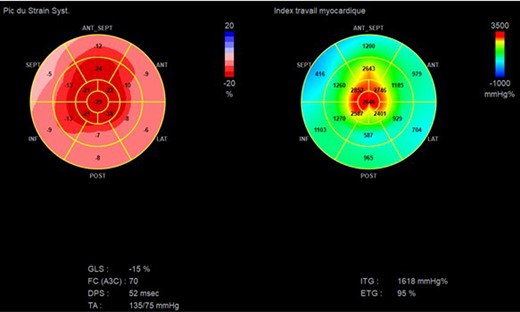-
PDF
- Split View
-
Views
-
Cite
Cite
J Antonelli, E Curtis, G L'official, W Kosmala, E Donal, Evolution and prognostic value of left ventricular deformation and myocardial work parameters in Transthyretin Amyloid Cardiomyopathy, European Heart Journal - Cardiovascular Imaging, Volume 24, Issue Supplement_1, June 2023, jead119.271, https://doi.org/10.1093/ehjci/jead119.271
Close - Share Icon Share
Abstract
Type of funding sources: None.
Wild-type transthyretin amyloid cardiomyopathy (ATTR-CM) is an increasingly recognized condition. Prognosis is related to early diagnosis and treatment. It remains clinically challenging to estimate the risk for many patients at the time of the diagnosis. Myocardial work is a novel echocardiographic tool that improves the characterization myocardial impairment.
We sought to investigate the evolution in time and prognostic value of myocardial deformation and myocardial work parameters, in ATTR-CM patients.
We analyzed clinical, electrocardiographic, biological, and echocardiographic characteristics in 113 consecutive patients (median age 82 [77–85], 90,4 % men) diagnosed for a wild-type ATTR-CM based on international consensus. Baseline and 18-months follow-up evaluations were taken into account. All the data came from a single center and all the images were recorded on the same platform (Ve95, GE-healthcare).
Thirty-four patients died and twelve were hospitalized for heart failure at a median follow-up of 935 days (IQR 691–1159 days). Eighty-six patients were treated with Tafamidis.
Left ventricular end-diastolic diameter and thickness, left atrial strain during reservoir phase (LASr), Global, Apical and Basal Longitudinal Strain, Global Work Index (GWI), Global Constructive Work, and TAPSE significantly decreased from baseline to 18 months. Left ventricular Ejection Fraction (LVEF), Right Ventricular Free Wall Strain, Global Wasted Work (GWW) and Global Work Efficiency (GWE) did not alter significantly.
Using a multivariate analysis, two parameters could be highlighted for their prognostic value on baseline evaluation: GWW and Global Longitudinal Strain (GLS) were significantly associated with the risk of death and/or hospitalization for heart failure. Patients treated with Tafamidis had a significantly better survival.
GLS and Myocardial Work parameters, particularly GWW, might be used to improve the risk assessment of major events in ATTR-CM patients. The LV strain and myocardial work-based echocardiographic follow-up might be useful in this condition.

apical sparing and myocardial work
- myocardium
- electrocardiogram
- left ventricular ejection fraction
- echocardiography
- left atrium
- transesophageal atrial pacing stress echocardiography
- heart failure
- left ventricle
- cardiac amyloidosis
- diastole
- follow-up
- heart ventricle
- risk assessment
- diagnosis
- prealbumin
- patient prognosis
- consensus
- early diagnosis
- longitudinal strain
- tafamidis
- global longitudinal strain



